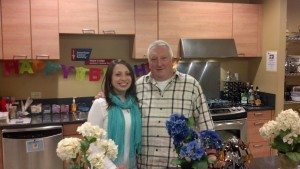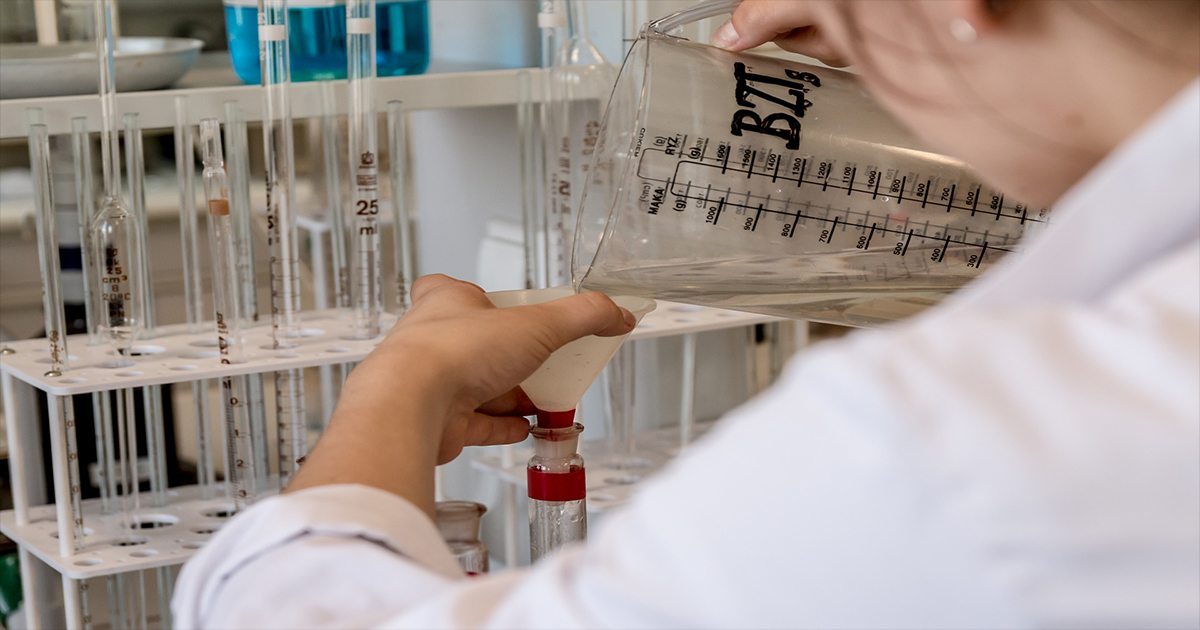Mesothelioma Help Cancer News

I Wish I Could Have Frozen Time Without Mesothelioma
I can’t believe that the lives of my family have been affected by mesothelioma for over five years. It’s impossible for me to believe that Dad has been gone for four of them. Where has the time gone?
Over these past 5 ½ years, my family has undergone many changes. Life continues on even though it feels as though time is stagnant. I remember in the days immediately following my father’s diagnosis walking through the halls of the hospital. I watched people smile, wondering how they could be happy in the same time that my life was falling apart. Patients were being discharged onto a full recovery; as happy as I was for them, I couldn’t help but wonder what shape my Dad’s life was going to take.
Knowing what I do now, I would have liked to fast forward time to three months later and freeze it with Dad at that point. He had a clean bill of health; no evidence of disease on his scans, and getting stronger every day after the ravaging effects of chemotherapy. He was happy, and hopeful that life would go on as if meso had never entered his life. If I could have kept him that way forever, I would have. But we all know that’s not possible.

Don Smitley and Jennifer Gelsick
Looking at things from a rational point of view, we have to find a way to understand that, although time marches on, our memories, these moments frozen in time, can stay with us forever. We can choose to focus on the best of times instead of our hardest struggles. Keep those memories close to your heart; it is how I am choosing to remember my father, just the way he would have wanted.

Creative Scientists May Eventually Find a Simple Way To Monitor Mesothelioma Symptoms
MesotheliomaHelp has covered breakthrough technology that may seem more appropriate for science fiction articles, such as the Qualcomm Tricorder XPRIZE competition to design a handheld device to help diagnose health conditions, than for mesothelioma care. In another seemingly science fiction approach to medical care, scientists report a tattoo with “smart” ink could help monitor chronic health conditions.
Scientists from Harvard and MIT partnered in a “proof of concept” experiment to determine whether biosensitive inks could become a reliable standard as a biomedical monitoring device. The team wanted to find a way to check blood glucose levels, for example, without requiring a skin prick or wires, sensors and batteries, that are needed with today’s devices.
With mesothelioma, an asbestos-caused cancer primarily striking older patients, one issue with managing the disease is the co- conditions from which many of the patients also suffer. According to data, about three out of four people with mesothelioma are older than 65 years, and nearly half them may have medical problems, such as heart disease and diabetes, that also need to be monitored.
In seeking to find the “next generation after wearables,” the researchers determined they could use biosensors directly on the skin. Dubbing the project “Dermal Abyss,” the researchers turned to pig skin for their initial testing. Tattooing the inks onto segments of the skin, the researchers watched as the colors of the ink changed based on biomarkers. In one case, a green ink changed to brown indicating increased levels of glucose. In another, they shined a blue light on a green ink that intensified in color as sodium concentration increased indicating dehydration.
Mesothelioma patients undergoing chemotherapy and radiation are also vulnerable to infection, dehydration and exhaustion from the harsh drugs. Finding a way to more closely monitor these symptoms could help get the patients back on their feet more quickly. Nearly 3,000 Americans are diagnosed with mesothelioma each year.
The researchers point out that this tattoo is still in the very early stages and “The purpose of the work is to light the imagination of biotechnologists and stimulate public support for such efforts,” said Nan Jiang, a postdoctoral fellow at Harvard Medical School and Brigham and Women’s Hospital.
“These questions of how technology impacts our lives must be considered as carefully as the design of the molecular sensors patients may someday carry embedded in their skin,” said Jiang.
Photo Credit: Harvard Medical School

“Grand Gestures” After A Mesothelioma Diagnosis
Anyone with a diagnosis of cancer knows how it can make you look at your life and how you are living it a little differently. Some cancer patients make radical changes – such as quitting a job, finding more meaning in spirituality, or taking on something that they always wanted to do and doing it. These changes can sometimes be life changing. In the July 28 issue of Cure, the article “Patients With Cancer Find Purpose in Radical Feats,” highlights people who have been diagnosed with cancer and have then done something new, something that they wanted to do now that their life may be ending. The cancer diagnosis allowed them to find the inner strength they needed to take on these challenges. One patient climbed Mount Everest, another started a major fundraiser for metastatic breast cancer.
In addition to making big changes and undertaking grand gestures, for some people, it is finding the joy in everyday tasks. All of our life’s journeys are uniquely our own, all are experiences that affect the unique way we our lives. Part of living is facing our own mortality. As uncomfortable as it is to think and talk about, we are all going to die.
Recently, I was talking to a survivor of malignant pleural mesothelioma. He was in his late 60’s and had been diagnosed 18 months ago. Since then he had surgery, chemotherapy, and was back for a possible reoccurrence. Before his diagnosis, he had been working, avoiding retirement, unsure if he ever would retire. He was fearful that he would retire and have too much time on his hands, and end up doing a lot of things he did not want to do in order to keep his wife happy. He did not see retirement as an event to look forward too.
Now 18 months later, he has put his diagnosis of malignant pleural mesothelioma in a positive light. He is grateful for every shared trip to the grocery store, doing errands together, going out with friends. For him, being diagnosed with cancer gave a different meaning to his retirement. He has a new sense of purpose, enjoying every minute of his life. The cancer diagnosis has put work and living in perspective. As he said, “What I feared about retirement is now what I enjoy and live for.”
For some people, a cancer diagnosis can spur major changes, for others it can make them appreciate what has always been in their lives. It can change your outlook on what is and is not important. Everyone’s response will be as unique as they are. Facing our own mortality will do that to us!

Vasiliki Kampas – Scholarship Essay Contest
Essay by Vasiliki Kampas
Cancer has been an insatiable beast claiming lives, and radically changing many lives since the dawn of humankind. Cancer seems to be an inevitable part of life, but does it always have to have so many victims? Many lives have been robbed by cancer and many more have been severely affected and dramatically changed. Some types of cancer develop in old age, and are considered inevitable by many doctors and physicians. However, there are many forms of cancers claiming innocent lives too early, one of which is Mesothelioma. Mesothelioma is an aggressive type of cancer that occurs in the thin layer of tissue that, covers the majority of your internal organs (Mesothelioma, Mayo Clinic). Mesothelioma has claimed many lives, including my grandfather’s.
I never got to meet my paternal grandfather, because Mesothelioma claimed his life many years before I was even born. My grandfather was working with asbestos and back then in the 1960’s-1970’s in Greece they did not know the effects of asbestos on one’s health. After working for years with asbestos, he was diagnosed with pleural cancer which is now referred to as pleural Mesothelioma. My paternal grandparents were very poor and they could not afford treatment, so my grandfather passed away, while being in excruciating pain. My father was 12 years old when his father past away, and because he was the oldest child in the family, he had to drop out of school to help provide for the family and help pay the family’s bills. He never got to finish elementary school, because he had to drop out right before he had the chance to graduate.
The death of my grandfather dramatically changed, and shaped my father’s life and this experience subsequently shaped his children’s lives; my life. My father always likes to tell stories about his father, who passed away too soon from Mesothelioma, and he always makes me wish I had the chance to meet my grandfather. Because my father never got to finish elementary school he made sure, that his children would get the best possible education and therefore he worked two jobs, trying to make ends meet. He loved school and his yearning to go back to school, influenced us deeply making me and my siblings try to strive for the best. My father always wanted to be a doctor, and help save lives, but he never achieved that dream. He did however start working at a hospital as a stoker and handyman, and donated many hours volunteering and spending countless hours with cancer patients and sometimes, he would take us with him. My father says that losing his father so early of cancer, made him realize how precious life is and that we can never take anything for granted. He also taught us that no matter how hard life may get, if you have a strong sense of belief in yourself, you will persevere. Growing up, when we would feel blue about silly things, my father would tell us all the things he went through when he lost his father and that helped put things into perspective.
The hours that we donated with my father to help cancer patients, had a profound impact on my career choice, as I want to become a Social Worker and help children who are battling cancer and other illnesses and diseases. Making a difference in a child’s life who’s battling cancer is very important to me. One of my aspirations is to work with for the Child Protective Services and make sure all children are in loving and caring homes. I would also love to work for the Los Angeles Children’s Hospital, and volunteer there as a social worker and help children and their families battling cancer and all diseases, that no child should be battling. Being there to help children and their families during one of their hardest times in life is what I really want to do.
Cancer is racking up victims, and more often than not we can avoid this by taking appropriate measures, and most importantly by raising awareness. According to the National Cancer Center “In 2016, an estimated 1,685,210 new cases of cancer will be diagnosed in the United States and 595,690 people will die from the disease (National Cancer Center)”. Approximately 3000 cancer cases will be mesothelioma related cases. Every year more than 3000 people in the United States are diagnosed with Mesothelioma due to asbestos exposure. Asbestos is a silent killer, and bringing awareness to this matter may help save thousands of lives. By making people aware of Mesothelioma and the dangers lurking in asbestos, we could potentially help save thousands of innocent lives.
Mesothelioma caused by asbestos, has taken away too many loved ones. It is high time we prevented to untimely deaths by raising awareness. It is of extreme importance to raise awareness within families, because if one family member is coming in contact with asbestos, then the entire family could get severely impacted by the asbestos particles that may find their way into the home. Another reason for raising awareness is to get people to have their houses checked for asbestos, especially if the houses were build prior to 1990, since asbestos was used in home construction. You can never bee too safe when it comes to asbestos.
One thing mesothelioma and cancer taught my dad, is that it may steal your loved ones away from you but it can never rob the memories you have made with them. And no matter how hard life gets, no matter how many hardships you go through, we are blessed to have a today. I had to learn the same lesson my father learned, when cancer stole away my maternal grandfather, who was like a second father to me. I was there to witness every moment of the devastating effects cancer had on my grandfather. He died within only two months after this diagnosis of urinary bladder cancer; it was a rapid form of cancer that sucked the light out of him. Within two months he was a shell of his former self, and it was hard on everyone in the family, especially my father who lost a second father from cancer 40 years later. I hated cancer for what it did to my grandfather, but then I realized that I have all these precious memories with him, and that’s how I choose to remember him; not on his deathbed, but as he was when he was enjoying life. To people who are battling cancer I would say “ You are extremely brave, you can do this, and you are loved.” To a family who has lost a loved one to this disease I would tell them to cherish their memories and hold on to the good ones. You may feel like you’ll always feel this way, but you won’t. I was devastated by my grandfather’s death, but I kept on living for him, because that’s what he would have wanted. “Keep going through life, as you normally do, and then one day, it won’t hurt as much. One day, things will be slightly brighter. Life is a worth living, and your loved one will have wanted you to remember them and keep on living. Keep making them proud. That’s what I try to do.
Works Cited:
- “Cancer Statistics.” National Cancer Institute. N.p., n.d. Web. 25 Mar. 2017.
- “Mesothelioma.” Mayo Clinic. N.p., n.d. Web. 25 Mar. 2017.
About
 Vasiliki Kampas
Vasiliki Kampas
My name is Vasiliki Kampas, and I am an aspiring social worker. I want to earn my B.A. in social work and then earn a M.A. and Ph.D. My dream is to work with Child Protective Services and make sure children feel safe and cared for. I love children and want to make a difference in their lives. The message I would like to give families fighting with mesothelioma is “You are brave, you are strong, you are loved!”

Seize the Day – Scholarship Essay Contest
by Katie Keynton
Mesothelioma. This word never meant anything to me, then it progressed malignantly. In my life, in my families’ life, and in the root of my family – my grandmother. It hurt everything it touched, and never got better. There was little to no cure, just chemotherapy and clinical trials.
But in every second that it spread, it taught me how to take advantage of every minute. “Seize the Day” is a quote my grandmother wrote in a letter to my older brother for his Senior Retreat. This was right before mesothelioma decided to take away her precious gift of life.
I was in the seventh grade when my mom received a phone call from my grandfather saying that my grandmother had only six to nine months left to live. I remember being in the other room just hearing her scream in a way that is just too hard to put into words. It had so much pain behind it, which is what I’ve decided cancer brings whenever it enters into someone’s world. It’s weird how one word can impact so many people. Cancer changes one’s world as soon as they encounter it. I never understood what this word meant until my grandmother was diagnosed with mesothelioma; a cancer in the lining of the lungs. Before reading about mesothelioma on MesotheliomaHelp.org, I still did not fully understand what it was. I learned about the different stages and to what parts of the body it can spread. At the time, I was only old enough to grasp a small concept of what cancer was in its entirety. I was worried about not being able to spend many important moments with my grandmother, that other people would have their grandmothers.
I knew that I wanted my grandmother to be a part of one special moment in my life, and that was my Confirmation in the Catholic Church. My grandmother converted to Catholicism later in life, and ever since, she has been a devout Catholic. Since I knew her time was limited, I wanted her to be my sponsor. It meant so much to her and me. During those last six to nine months, she told me she was going to make the best of everyday. She never let a day go by without it being special. When my Confirmation day came around, she made it a point to make it something that we would both remember. She gave me a silver heart-shaped necklace with Mary, the mother of Jesus, imprinted on the outside that I still wear on special occasions- especially when it is a moment I wish that she were there with me. My Confirmation date was a few months after she had been diagnosed with mesothelioma. She ended up living so much longer than we expected. With her age, being about sixty-seven at diagnosis, the doctors did not have a hopeful outlook on how long she would make it.
She had been exposed to asbestos as a child from her father. Working in the shipyards in Virginia, he was exposed to asbestos everyday, in which he unknowingly brought home on his clothes for his children to breathe. She also had worked at a bank where construction workers did not take proper precautions to protect against asbestos. Inhaling asbestos fibers everyday at the bank did not help her case later on in life. Because of these two types of exposure, she developed mesothelioma. Her father had passed away from mesothelioma as well, which is what helped the doctors determine what she had. It was kind of funny when we all found out that she was the one to get cancer because she was the healthiest one out of all of the family. There was no way she could get sick unless it were an outside force such as cancer. She ate mostly fruits and vegetables everyday. She would treat herself to ice cream on the porch after dinner some days and just enjoy the sunset. She knew how to take in every moment of life. Although she had an illness, she did not let that affect her from living her daily life.
A couple of years passed by and she was still doing great. She was outliving her expectancy rate given by the doctors and battling hard against chemotherapy and clinical trials at NIH in Bethesda, MD. Her youngest son had gotten married, and with a baby on the way, life seemed to be looking up. Everything seemed to be so joyful, until we found out that the cancer had moved to other parts of her body. She started to get progressively worse, and this time, we knew it was coming. When she passed away, I was a freshman in high school. We all went to visit her because the doctors had said that the time was coming. She talked to each one of my siblings and I in private. She told me to enjoy every moment because you do not know how much time you have left on Earth. She also advised me to eat healthier because all I ever ate was sugar, which was one-hundred percent true. The number one rule she told me was to make a difference in as many lives as I could and do what makes me happy. Ever since that day, I have lived each day in memory of her.
She impacted my life so much more than the words in this essay could express. She still helps me live life to its full potential, without her humanly being present. I began to do a lot of volunteer work in nursing homes and in preschools, while keeping her in mind. Without her final words, I may not have found my true calling. By doing mission work and learning Spanish, I have found the two things I am most passionate about. These two influences motivated me to get involved in a mission trip to Ecuador. The objective of this mission trip was to build a house for a family in need, in which the mother had AIDS. Making a small difference in any life that I touch, through mission work or daily life, helps me give back to those who are going through a similar situation as my grandmother. Because of her illness, I have decided to do something in the medical field in which, being able to help others, creates an immediate positive repercussion in the world. My goal is to become a doctor or Physical Therapist and travel for a month or two every year to a Spanish-speaking country and do mission work. I want to reciprocate the love and care that the other doctors had done for my family. These were the words she wanted me to live by and that influenced the career path I chose, and so I do it in memory of her.
I know it sounds cliché trying to tell anyone who knows someone with mesothelioma, or someone who has it, that it is hard and that it is a journey, but it also has its benefits, because it teaches you how to savor the most beautiful moments in life. There are often moments that you miss by paying attention to your phone instead of spending time with your family. There are also moments that you miss by not looking at the overall beauty of the most simplistic components of life itself. Take advantage of every second God gives you with the people you love, because you will one day regret not doing so. It is hard, but you can make it through and become stronger from it. You should never give up fighting, because the people around you need you and love you. If you give up, then you are letting the cancer beat you, instead of you beating the cancer. Give yourself that chance to create more memories with the people you care about.
Raising awareness for this is important because no one else should have to go through what my grandmother had to. Mesothelioma is preventable just by taking proper precautions when tearing down old buildings or breaking apart cement. There should be proper precautions when doing so. If awareness were raised about this, those precautions would be met. Knowing that the suffering of my grandmother could have been prevented just makes me want to promote awareness even more. Overall, cancer is one of the most difficult obstacles that today’s society has to deal with, but we can get through it, and we can promote awareness to make cancer less widespread.
- Works Cited “Causes of Mesothelioma and Asbestos Exposure.” Mesothelioma Help. N.p., n.d. Web. 09 Oct. 2015.
- Flaccus, Q. Horatius, and David West. Horace Odes I: Carpe Diem. Oxford: Clarendon, 1995. Print.
- “Mesothelioma Prognosis Can Vary Depending on the Stage.” Mesothelioma Help. N.p., n.d. Web. 09 Oct. 2015.
About
 Katie Keynton
Katie Keynton
I am a Freshman at the University of Kentucky. I love to travel and do volunteer work. I have gone to Ecuador to build houses for those in need , and I went to Spain to visit my exchange student. I love spending time with my friends and family and helping others. I knew about mesothelioma because both my grandmother and great grandfather died from it.
Free Mesothelioma Patient & Treatment Guide
We’d like to offer you our in-depth guide, “A Patient’s Guide to Mesothelioma,” absolutely free of charge.
It contains a wealth of information and resources to help you better understand the condition, choose (and afford) appropriate treatment, and exercise your legal right to compensation.
Download Now Vasiliki Kampas
Vasiliki Kampas Katie Keynton
Katie Keynton